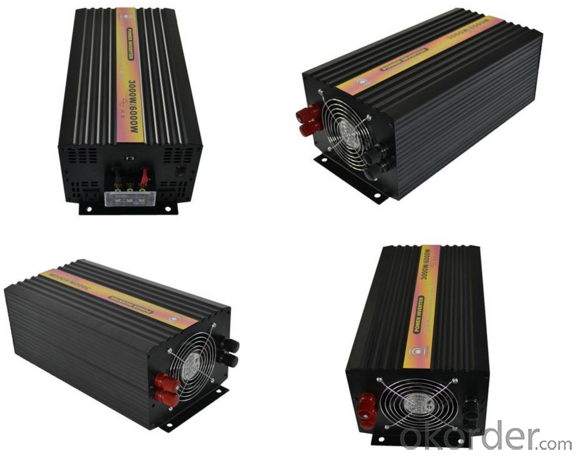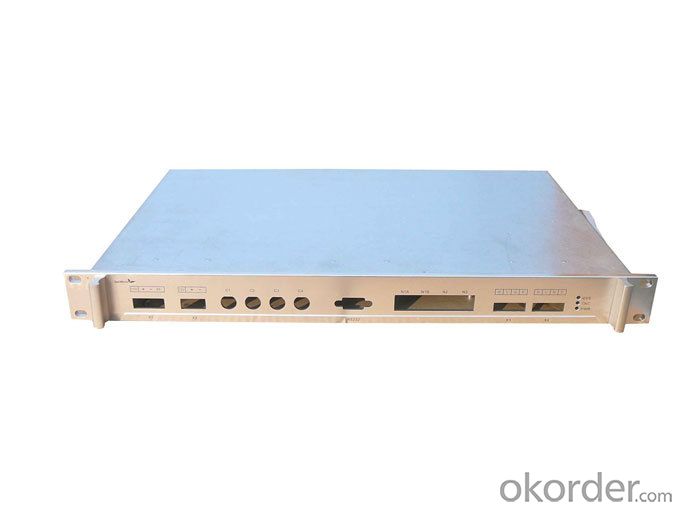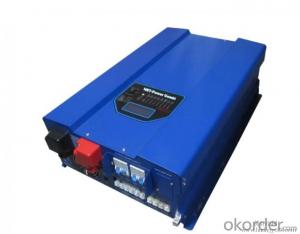Micro Inverter M600 Solar Inverter made in China
- Loading Port:
- Shanghai
- Payment Terms:
- TT OR LC
- Min Order Qty:
- 0 watt
- Supply Capability:
- 10000 watt/month
OKorder Service Pledge
OKorder Financial Service
You Might Also Like
Description of Micro Inverter Solar Inverter
Solar ac power system consists of solar panels, charge controllers, inverter and battery; Solar energy does not include inverter dc power system. Inverter is a kind of power conversion device, inverter by incentives can be divided into self-excited oscillation inverter and separately excited oscillation inverter.
Features of Micro Inverter Solar Inverter
Standard 10 years warranty, 5-15 years optional
High effiency (Max.96.7%)
AC/DC high frequency isolation technology
Maximum connection of 14 Micro-inverters
Adopted electric power carrier communication
Easy design,Plug-and-play chain installation
Remote monitor to each module
Reduce shading issues, improve the generating Reduce shading issues,improve the generating
integrated ENS function, complied with safety standard, can be connected to grid directly
Advantages of Micro Inverter Solar Inverter
Longer life cycle
Plug and play
Free monitoring through our webportal
Very lower internal temperature
Easy transportation and installation
Faster CPU speed
Adjustable active and reactive power
Real-time data readable at night
PID effect protect
Technical Data of Micro Inverter Solar Inverter
Type | Omniksol-M600 |
Input(DC) | |
Recommended PV Module Power | 2x(200-310)W |
Max,DC Voltage | 60V |
Operating Voltage Range | 16-60V |
MPPT Voltage Range at Nominal Power | 27-48V |
Max, Input Current | 10.0Ax2 |
Max, DC Short Cicuit Current | 14A |
Output(AC) | |
Nominal AC Power | 500W |
| Nominal AC Current | 2.17A(230V),2.08(240V),2.4A(208V) |
Nominal Grid Voltage | 230V/240V/208V |
Nominal Grid Frequency | 50Hz/60Hz |
Grid Voltage Range* | 230V/200-270V,240V/211-264V.208V/183-229V |
Grid Frequency Range* | 45.5-54.5Hz/57-62.5Hz |
Power Factor | >0.99 |
Total Harmonic Distortion(THD) | <3% |
Night time Power Consumption | <50mW |
Maximum Units Per Branch | 7 |
Efficiency | |
Max,Efficiency | 96.7% |
CEC Weighted Efficiency | 96.5% |
MPPT Efficiency | 99.5% |
Reference Standard | |
Safety Standard | EN 62109, AS/NZS 3100 |
EMC Standard | EN 6100-6-1, EN 6100-6-2, EN 6100-6-3 EN 6100-6-4, EN 6100-3-2, EN 6100-3-3 |
Grid Standard | VDE-AR-N4105. VDE-0126-1-1,G83/1,EN 50438,RD1699,CEI 0-21, AS4777,C10/C11 |
Physical Structure | |
Dimensions | 252x250x28mm |
Weight | 2.5kg |
Environmental Protection Rating | IP 67/NEMA 6 |
Cooling Concept | Natural convection |
Overvoltage Category | PVⅡ/Mains Ⅲ(According to IEC 62109-1) |
General Data | |
Operating Ambient Temperature Range | -40℃ to +65℃ |
Operating Internal Temperature Range | -40℃ to +85℃ |
Isolation Type | HF Transformerless |
Communication | Wire communication |
Standard Warranty | 15 Years (5-25 years optional) |
IMages of Micro Inverter Solar Inverter



FAQ
Q: Do you have the CE, TUV, UL Certification?
A: We’ve already passed all the tests, and any certificate is available.
Q: Have you ever sold your products to companies in my country?
A: Of course, we have customers in all general PV markets, but I think we should expand our market share along with the market growth.
Q: When did your company set up? You are a new company, how can I believe your quality?
A: We entered into Solar PV industry in 2005, now we have several plants in manufacturing of a-Si and c-Si panels, and our capacity is 220MW per year. Till now we have already passed all the tests by authorized laboratories, e.g. TUV, CE, UL.
Q: Can you help us install the module if we cooperate with you?
A: We haven’t entered into installation sector, but we have the plan in near future.
Q: How do you pack your products?
A: We have rich experience on how to pack the panels to make sure the safety on shipment when it arrives at the destination.
Q: Can you do OEM for us?
A: Yes, we can.
Q: Can we visit your factory?
A: Surely, I will arrange the trip basing on your business schedule.
- Q:Can a solar inverter be used in systems with multiple inverters?
- Yes, a solar inverter can be used in systems with multiple inverters. In fact, in large-scale solar installations, multiple inverters are often used to handle the increased power output. These inverters are connected in parallel or series to ensure efficient and reliable operation of the entire system.
- Q:What is the role of a synchronization circuit in a solar inverter?
- The role of a synchronization circuit in a solar inverter is to ensure that the inverter is synchronized with the utility grid. This circuit monitors the frequency and phase of the grid and adjusts the inverter's output accordingly to match the grid's characteristics. By synchronizing the inverter with the grid, it allows for safe and efficient power transfer, prevents disruptions to the grid, and enables the inverter to operate in parallel with other power sources.
- Q:Can a solar inverter be used with different communication protocols?
- Yes, a solar inverter can be used with different communication protocols. Many modern inverters are designed to be compatible with various communication protocols such as Modbus, RS485, Wi-Fi, or Zigbee. This allows them to communicate and integrate with different monitoring systems, smart home devices, or other renewable energy components, providing flexibility and compatibility for users.
- Q:What is the difference between a grid-connected inverter and an off-grid inverter? What are the advantages of a hybrid inverter?
- Offline generally need energy storage, not to send energy to the Internet. Grid has no right to interfere.
- Q:Can a solar inverter be used with battery storage?
- Yes, a solar inverter can be used with battery storage. In fact, it is commonly used in solar energy systems to convert the direct current (DC) power generated by solar panels into alternating current (AC) power that can be used by household appliances or stored in batteries for later use. The solar inverter plays a crucial role in managing the flow of electricity between the solar panels, batteries, and the electrical grid, ensuring efficient energy utilization and storage.
- Q:How do you calculate the payback period for a solar inverter?
- To calculate the payback period for a solar inverter, you need to determine the initial cost of the inverter and the annual savings or earnings it generates. Divide the initial cost by the annual savings or earnings to determine the number of years it will take to recoup the investment. This will give you the payback period for the solar inverter.
- Q:Are solar inverters compatible with battery storage systems?
- Yes, solar inverters are compatible with battery storage systems. In fact, solar inverters are an essential component of a battery storage system as they convert the direct current (DC) power generated by solar panels into alternating current (AC) power, which can be used to charge and discharge batteries. This allows for the efficient integration of solar energy with battery storage, enabling users to store excess solar power for later use, improving energy independence and reducing reliance on the grid.
- Q:What are the safety certifications for a solar inverter?
- Some common safety certifications for solar inverters include UL 1741, IEC 62109, and CSA C22.2 No. 107.1. These certifications ensure that the inverters meet specific safety standards and requirements, such as protection against electrical shock, fire hazards, and grid stability.
- Q:Can a solar inverter be used with a solar-powered agriculture system?
- Yes, a solar inverter can be used with a solar-powered agriculture system. A solar inverter is essential for converting the direct current (DC) electricity produced by solar panels into alternating current (AC) electricity required to power electrical devices and equipment used in the agriculture system. This allows for the efficient utilization of solar energy for various agricultural applications such as irrigation systems, pumps, lighting, and other electrical equipment.
- Q:What are the communication protocols used in solar inverters?
- The communication protocols commonly used in solar inverters are Modbus, SunSpec, and DNP3. These protocols enable the inverters to communicate with other devices and systems, such as monitoring software, energy management systems, and smart grids, to exchange data and control commands.
1. Manufacturer Overview |
|
|---|---|
| Location | |
| Year Established | |
| Annual Output Value | |
| Main Markets | |
| Company Certifications | |
2. Manufacturer Certificates |
|
|---|---|
| a) Certification Name | |
| Range | |
| Reference | |
| Validity Period | |
3. Manufacturer Capability |
|
|---|---|
| a)Trade Capacity | |
| Nearest Port | |
| Export Percentage | |
| No.of Employees in Trade Department | |
| Language Spoken: | |
| b)Factory Information | |
| Factory Size: | |
| No. of Production Lines | |
| Contract Manufacturing | |
| Product Price Range | |
Send your message to us
Micro Inverter M600 Solar Inverter made in China
- Loading Port:
- Shanghai
- Payment Terms:
- TT OR LC
- Min Order Qty:
- 0 watt
- Supply Capability:
- 10000 watt/month
OKorder Service Pledge
OKorder Financial Service
Similar products
New products
Hot products
Hot Searches
Related keywords






























